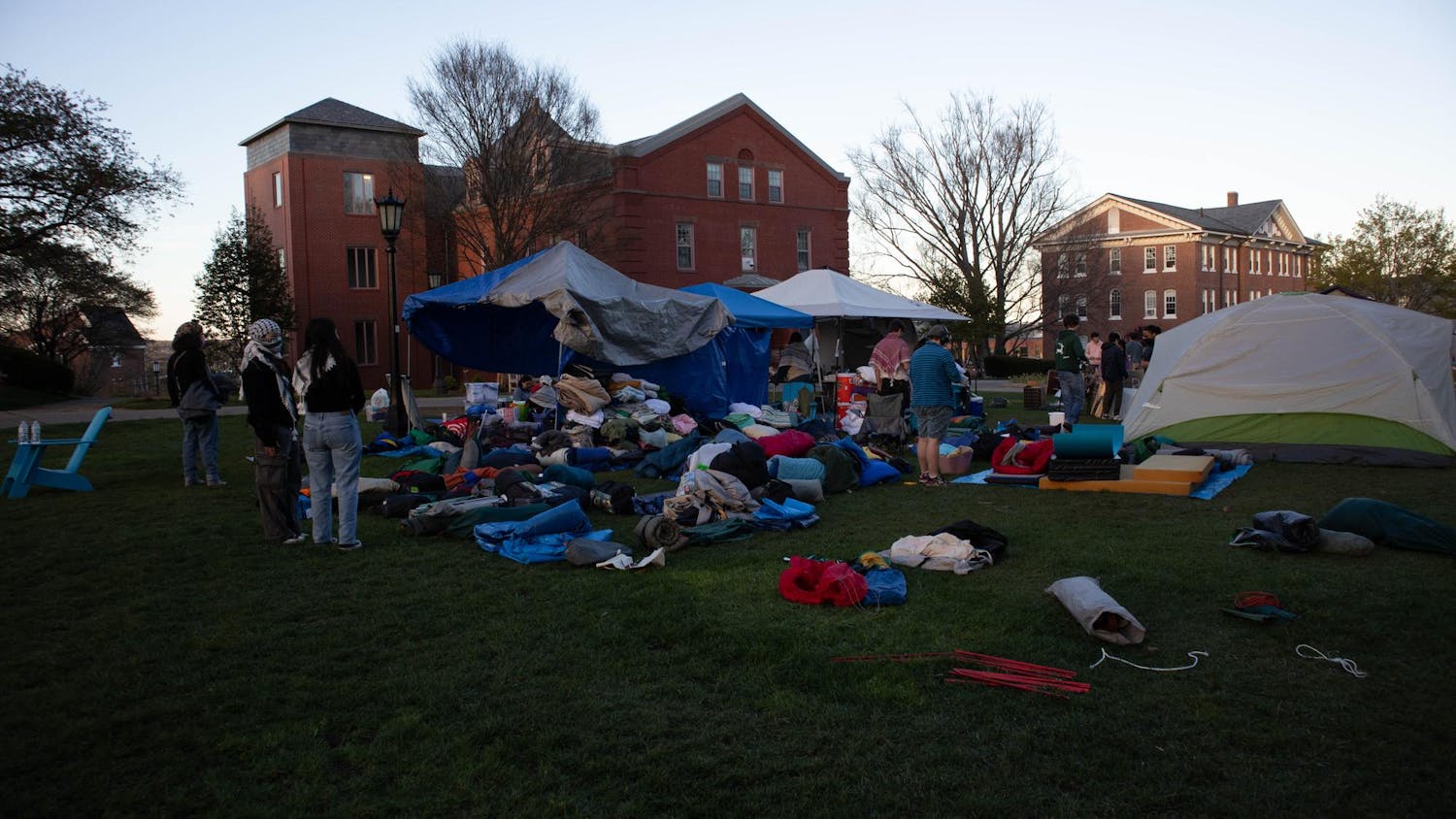The Athletics Department enacted several changes this semester to the Club Sports program, including new caps on roster sizes and the introduction of a rule prohibiting A and B teams from playing games in separate locations, following funding decrease program. These changes have caused leaders of club sports teams to take measures to adapt, according to Assistant Director of Athletics Branwen Smith-King.
Smith-King said that the Tufts Community Union (TCU) Allocations Board provided $115,000 in funding last year for teams, which were distributed to independent club sports teams by Athletics, but for the 2016 fiscal year, the board decreased allocated funds to a lump sum of $100,000.
TCU Treasurer Shai Slotky explained that while he did not control this budgeting at the time of the allocation, it is to his understanding that the funding cuts were made with the assumption that the money would be covered by Athletics.
"This sum was budgeted with the assumption that there would not be a resounding negative impact on club sports in accordance with an offset of administrative costs," Slotky, a junior, told the Daily in an email.
Smith-King, however, said that Athletics was never meant to cover the differences in the budget.
The new budget for the 2017 fiscal year will be released for club sports and other Senate-funded student organizations this Sunday at the weekly Senate meeting.
Several teams have been affected by the funding changes, including the men’s rugby, women’s rugby, men’s ultimate frisbee, women’s ultimate frisbee and indoor rock climbing teams. While each team was affected in different ways and dealt with the changes differently, members of the teams explained that the club sports infrastructure does not currently have the capacity to sustain the level of student interest.
"There is more work to be done to resolve a cloud of issues that has been looming over all involved for some time now, and we want to make sure that club sports athletes have all the support that we can possibly give them," Slotky said.
Roster Changes
The Athletics Department enforced limits on roster size because the number of interested club sports players exceeded available resources, including facility space and sports medicine staff, according to Director of Athletics John Morris.
“The Club Sports program proposed to return rosters to their typical sizes after certain teams’ rosters grew to a point where their size began to raise safety, facility and administrative concerns,” Morris wrote to the Daily in an email.
Roster size constraints particularly affected rugby and ultimate frisbee teams, which require the oversight of sports medicine staff because they are considered contact sports, according to Smith-King.
“Sports Medicine provides trainers to the rugby and ultimate frisbee club teams because of the risk and prevalence of injury in those two sports,” Nick Mitropoulos, director of Sports Medicine, said.
Club sports share trainers with varsity sports, and ultimately, the large roster sizes of these teams trainers exceeded the staff of Sports Medicine, according to Smith-King.
"In recent years, rosters for some club teams grew significantly larger...and created challenges related to the availability of athletic facilities and sports medicine resources, the safe and efficient conduct of practices and the provision of proper administrative oversight,” Mitropoulos said.
Due to similar concerns about oversight, the Club Sports program eliminated the practice of B teams playing at different locations than the A teams for relevant teams.
"We want a manageable roster," Smith-King said, referencing what she told club sports team leaders. “If you want to have more players on the team, you can have a second team if you want but only if they’re competing at the same site.”
Club sports administrators initially discussed cutting the rosters of men’s and women’s rugby teams to 30 spots, so that teams would only have 30 players available to practice and play, according to Smith-King. This concerned the presidents of rugby and frisbee teams because they felt this would not allow enough spots for alternates when players get injured.
“Rugby is a really dangerous sport so usually on average at any point we can have up to 10 injuries," Nick Nasser, president of the men’s rugby team, said. "People can’t play if they’re injured, and we wouldn’t want them to play. We wanted to have enough wiggle room to account for injuries.”
Women’s rugby team president Alison Kuah, who was a former Daily executive sports editor, shared similar concerns about how the roster cap limits the team’s ability to have sufficient players on the bench. Kuah, a junior, said that there are 15 positions in rugby and with a cap of 30, each position would only have one alternate.
Additionally, the rugby presidents said that because rugby is a new sport for most college students, players require a lot of time to simply practice the spot before they are a ready for the danger and intensity of a real game. With a roster cap, the presidents argue that new players will not receive the experience they need.
“People come into college never playing rugby before,” Nasser, a junior, said. “They come in, and rugby is a really dangerous sport, so if you don’t have the right coaching and you don’t have the right experience, throwing you into a game can be a serious risk for your health.”
“If you’re worried about our safety we should be focused on….not on the number of people because if you restrict the number of people they have [fewer] opportunities to practice and train so their muscle memory is not there which you need to play in a game,” Kuah said, noting that she spent two years practicing with the rugby team before she was ready to participate in a real game.
However, Mitropoulos explained that limiting roster sizes for club sports is the safest option.
“In our experience, larger rosters mean that more people, particularly those participating in collision and contact sports, are at risk of injury,” he told the Daily in an email.
However, Smith-King said that the program administrators are now planning on raising the roster size limit to 40 players for fall 2016, following NESCAC regulations. Nasser said that while he was satisfied with this change, ideally he believes there should not be a roster cap. Kuah explained that for women's rugby, the roster cap would ideally be 50.
Ashlyn Salvage, captain of the women’s frisbee B team, had similar concerns about the effects of new roster caps for the development of new players. The frisbee team — which this year has 65 players on the women’s combined A and B teams and around 70 or 80 for the men’s combined A and B teams — was originally capped by the Athletics department to 40 people for both the A and B teams, according to Salvage.
“People don’t play [frisbee] in high school so you learn in college and you learn on the B team,” Salvage, a junior, said. "And there’s no way to learn that’s not [that]. The thing about cutting people from playing their freshman year is that even [not having] a B team means there’s no future for the A teams.”
While the rugby teams rely more heavily on their older, more experienced players, they do not have a formally designated B team due to lower participation numbers than frisbee teams.
While the frisbee A teams have always had 20 people, Salvage said that the roster for a B team cannot be that small. The commitment levels for A teams requires commitment similar to a varsity sport, unlike B teams.
“[The roster cap is] not really sustainable for the B team because B team is less of a commitment so people come when they can. So if 10 people can’t come that day, then we can’t play because you can’t play a tournament with 10 people,” Salvage said.
The ultimate frisbee team was also particularly affected by the club sports stipulation that B teams could not play games at different locations than A teams.
Salvage explained that every year, the B team trains for developmental sectionals, called B sectionals by the frisbee team. If the team wins, they can qualify to A regionals, which Salvage said they do every year. However, A sectionals and B sectionals are always the same weekend, and following the new rule, the B team could not compete in its sectional tournament, and thus would have no chance at attending A regionals.
“It’s hard to be competitive if you don’t have something you’re working for,” Salvage said.
However, given that these changes were announced during ultimate frisbee’s season, Athletics was willing to negotiate with the frisbee team and meet some of its demands. For the 2016 season, Athletics agreed to a 50-person cap and allowed the A and B teams could play at different locations for its games, according to Salvage and Smith-King.
“For this semester, I am satisfied,” Salvage said. “It definitely sucks so much to tell someone they can’t play with you, especially [when] there’s no other way to play frisbee. There’s no intramural team here. I’m definitely scared for the future.”
Men’s and women’s rugby seasons, however, are in the fall, and it is currently unknown whether they will be able to similarly negotiate with the club sports program to more favorable terms.
Funding
Club sports are funded by TCU Senate, which decreased its overall allocated funds for the 2016 fiscal year, according to Smith-King. Club sports teams can also reach into their own fundraising and into a buffer fund established by Athletics within the $100,000 Senate budget, according to Morris.
Decreases in funding have affected several teams, including the indoor rock climbing team, which had a 40 percent decrease in its budget, according to the team's co-captain Brooke Weil. This directly impacts the team’s roster size, as the team must pay individual fees for each climber to compete, she said.
“We had over 35 people on our roster who wanted to compete," Weil, a sophomore, said. "We probably could have had more if we phrased it differently, but we phrased it as look guys we’re going to have to make cuts because we have no money."
Weil and co-captain Francesca Caiazzo said that the lack of funding forced the team to compete only in the regional qualifying competition and not compete in lower-level events, which would give them additional practice.
While TCU controls the lump sum that all club sports combined receive, it is up to the Club Sports program administration to divide how much each team gets, Smith-King explained.
Caiazzo, a junior, explained that this difference can sometimes lead to confusion about why cuts are made.
“When our new budget was announced Bran [Smith-King] kind of posed it as, 'Oh, everyone’s budgets are smaller. It’s likely by a few $100, and then our budget was cut by $1,500,” Caiazzo said.
Smith-King wrote in an email that rock climbing's budget was based on the figures for the 2014-2015 year because the team failed to submit a budget for 2015-2016, which explained the cuts.
However, Weil and Caiazzo deny Smith-King's claim.
"Our 2015 Fiscal Year budget was submitted on March 12, 2015 by our previous captain, Emmett Moore, and myself. We submitted it into the Rock Climbing Google Drive folder, which created by the Club Sports assistant at time, Jo Clair," Weil wrote to the Daily in an email. "Protocol last year was that all documents go into this Google Drive folder, which was shared between Jo and our team leaders. If Branwen didn't receive this document, my only guess could be that some miscommunication [had] occurred between Branwen and Jo."
Moreover, the rock climbing captains said they were surprised that Smith-King explained their funding cuts in this way, as they said it was never mentioned to them.
"We have never...been accused of or confronted for not submitting a 2015-2016 budget, including during our end-of-year meetings last year," Weil said.
Other teams have had to tap into their fundraising budgets to compensate for the cuts, including men’s rugby, who unlike some teams, has to pay for its coaches.
“The budget cuts this year have forced us to really rely on our fundraising efforts," Nasser said. "We’ve been tapping into parents. We’ve been tapping into alumni."
Part of the frustration with club sports funding has to do with the indirect funding process, according to sophomore TCU senator Ariel Barbieri-Aghib, who focused on issues with club sports as her senatorial project earlier in the semester.
“The funding is really mismanaged,” Barbieri-Aghib, who is also an assistant news editor at the Daily, said. “It’s hard to access. It’s hard to know how much money you have, and there’s no streamlined process.”
Lack of Club Sports Infrastructure
One of the main motivators for Athletics’ caps on roster size and the stipulation that A and B teams must play at the same site is that there are not enough people who work in club sports to facilitate the volume of interest.
Smith-King is the director of club sports, which is just one of her many roles as assistant director of Athletics. While she does have an assistant, he only works six hours a week on club sports, she explained.
The team captains interviewed all said that the program administrators are significantly overburdened, given the minimal staffing in relation to the size of the program.
“Club sports at Tufts [do] not have enough support infrastructurally," Kuah said. "Bran and Mike are severely, severely overworked.”
Salvage said that the workload on the club sports administration was ultimately the root of many of the women's ultimate frisbee team's recent challenges.
“So much of the changes are because the Club Sports department is super overworked," she said. "It’s not that sports funding gets cut that affects us the most...it’s that no one’s getting paid to help us organize things."
Some, such as Barbieri-Aghib, believe this is because the Athletics department does not prioritize club sports.
"Athletics does not want club sports, so they would have to hire an outside person,” she said.
Morris explained that the resources provided are determined by what is possible at this point in time.
"We continue to discuss and evaluate staffing and the allocation of appropriate human resources in a variety of areas, including club sports, consistent with the availability of resources and overall needs," Morris said.
While Smith-King acknowledges it would be helpful to hire a full-time administrator, she understands that funds might be limited.
“There are so many priorities on this campus that I don’t where the money will come from to hire a full-time administrator,” Smith-King said. “Most schools like us have recreation departments [and] have one or two people to engage in recreation. We don’t have that; it’s all incorporated in the athletic department.”
Some club leaders feel that the lack of adequate staffing and oversight can lead to miscommunications.
“Branwen has a tough time because club sports was dropped on her desk, and she didn’t ask to run club sports, and she’s kind of come into it knowing nothing," Weil said. "Because of that she’s kind of had to make up the rules as we go.”
Many team leaders have expressed a desire for a rulebook to be created, which can be referred to in order to resolve these types of problems.
“There’s no written rulebook out there. There’s a club sports handbook, but it doesn’t cover a lot of things,” Weil said.
 Tufts Climbing Team members Justin Stearns and MP Monks climb during practice on Wednesday, April 6 at MetroRock in Everett, MA. (Max Lalanne/The Tufts Daily)
Tufts Climbing Team members Justin Stearns and MP Monks climb during practice on Wednesday, April 6 at MetroRock in Everett, MA. (Max Lalanne/The Tufts Daily)“So much of it has been verbal, and there isn’t a lot written rules everywhere,” Salvage added.
However, Smith-King said that club sports leaders are given sufficient information to know what the rules are.
“The Club Sports program issues a detailed manual to each club at the beginning of the year and provides updates each spring,” she said. “Additionally, club team leaders meet with the club sports program before each season to review rules and expectations."
While the Club Sports administration can barely support the number of teams that already exist, student interest continues to grow.
"We have the most offerings, but we also have the least facilities of all of the schools," Smith-King said.
There is a list on the whiteboard in Smith-King’s office with all of the club sports teams that the university would be interested in providing, but which Tufts does not have the resources to support.
“It’s not just money, but it’s facility, it’s medicine, it’s oversight — all those things we’ve had a moratorium on [for] our club sports for the past 3 years,” Smith-King said.
Five years ago the club sports department added nine sports, which only started receiving funding two years ago, she explained.
As students await the proposed TCU Senate budget for the coming year, the men’s and women’s rugby teams are still aiming at negotiating for more favorable terms, and other fall sports may act similarly as they enter their seasons. Meanwhile, many students are still eager to start new club sports organizations.
While Smith-King is excited about the strong interest, she thinks that the expectations surrounding club sports need to be adjusted.
“Our club team is really a privilege; it’s not necessarily a right,” she said. “We would love for as many people as possible to participate, but we can’t have 200 people playing rugby or 80 people playing Frisbee.”









